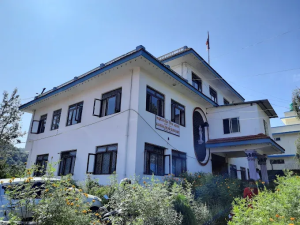Bagmati Province
Midday meal scheme fails to dissuade Ramechhap students from junk food
Most community schools have been providing lunch money to students instead of healthy food.
Tika Prasad Bhatta
Every morning before his children leave for school, Surya Bahadur Shrestha of Manthali Municipality-2 hands over some lunch money to them.
His children attend Nilkantheswar Secondary School, where the midday meal programme is in effect. But the school gives Shrestha and other guardians Rs15 per day per student under the programme rather than providing meals to children at school.
“Our family is a working-class family. My wife and I are busy from sunrise to sundown and we hardly have any time to pack lunch for children,” Shrestha said. “So I give them the money the school gives me. It would have been better for us if the school prepared healthy warm meals for students. But since they don’t do that, my children rely on junk food.”
The mid-day meal programme was introduced in 2017 in collaboration with the World Food Programme to ensure children in community schools get a healthy, nutritious diet. The programme aims to control malnutrition, reduce the number of school dropouts and encourage children to attend classes regularly.
The government introduced the scheme with the aim to ensure hunger does not keep students away from school but it has been mired in controversy and charges of corruption and irregularities.
The federal government provides Rs15 per day to each student up to grade six in the community schools through the local units.
According to the District Education Office, there are 396 community schools in Ramechhap and the government has not been able to effectively implement the mid-day meal scheme in any of the schools properly.
“There is no data available on how many schools in the district properly implement the mid-day meal programme,” said Bharath Bhattarai, head of Education Development and Coordination Unit, Ramechhap. “Some serve lunch cooked in the school but there are also schools that have not even set up a kitchen yet. The school gets the money from the government for the programme but instead of preparing a proper meal they distribute the money to the parents.”
According to the World Health Organisation, many low- and middle-income countries like Nepal have been facing a double burden of malnutrition as well as a rapid upsurge in obesity-related cases. Children in those countries are more vulnerable to prenatal, infant, and young child inadequate nutrition.
The government has prepared a set of rules for community schools to adopt in their midday meal programme to ensure that children get a healthy and nutritious diet.
This guideline includes cutting off junk food from the diet but in most community schools in the district children rely on junk food to keep hunger at bay.
Ram Chandra Adhikari, principal of Nilkantheswar Secondary School, says the school does not cook meals despite receiving money for the same from the local unit because the government provides the budget only for food. “They haven’t made any provisions for a cook, utensils and appliances needed to set up a kitchen,” said Adhikari. “So we don’t prepare meals at school. We instead give the money to the guardians.”
The shortcomings of the mid-day meal programme can be attributed to mismanagement, says Saubhagya Neupane, the head of the education unit of Manthali. “The schools have to make arrangements for the kitchen, cook and catering, but most schools have not done so,” he said.




 5.39°C Kathmandu
5.39°C Kathmandu (1).jpg)











%20(1).jpg&w=300&height=200)

